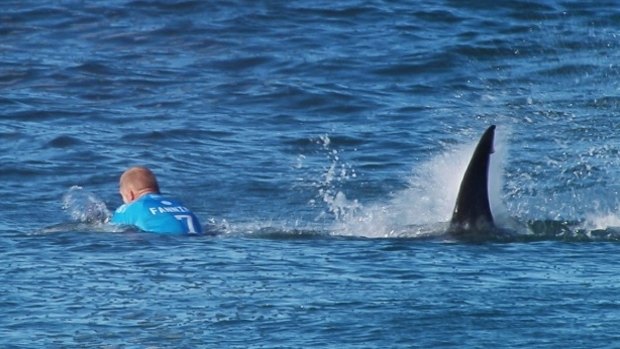This was published 9 years ago
Mick Fanning's response to kick, punch shark was perfect, says expert
By Megan Levy
- 'I was waiting for the teeth'
- Surfers react with shock
- Fanning's mum: I thought we'd lost him
- Fanning's friend Julian Wilson hailed as hero
Mick Fanning's instinctive move to punch a large shark that attacked him during a world championship surfing event in South Africa overnight was the perfect reaction to try to scare away the animal, a shark expert says.
In the moments after the incident at Jeffreys Bay, a clearly stunned Fanning said he kicked out and punched the shark on the back as it came at his board during the final of the J-Bay Open.
The species of shark has not been determined, but Marty Garwood, the senior aquarist at SEA LIFE Sydney Aquarium, said it was likely to have been a great white shark, common off the South African coast, or a bull shark.
Judging from what appears to be a tail fin at the start of the footage, the shark appeared to have been at least three metres long, he said.

The real deal: Mick Fanning battles with the shark at Jeffreys Bay, South Africa, in July.Credit: World Surf League
Mr Garwood said the shark might have mistaken Fanning's silhouette in the water for a turtle or a seal, and approached him to investigate.
"The way they investigate potential prey is to do one big bite initially, and wait back and see what it actually was, before they go in again," Mr Garwood said.
"That's unfortunately what can be quite damaging sometimes in these instances, but luckily not in this case."
Mr Garwood said that, after a shark made initial contact, the best reaction for a person to take in such a dire predicament was to strike out at the animal in an attempt to scare it away. That is precisely what Fanning did.

Mick Fanning and Kelly Slater hug after Fanning's close encounter with a shark. Credit: Twitter: @Michael_Stamp
"Big sharks are actually quite protective of themselves. They don't want to get injured in any way, so anything that you could possibly do, if you're in that close a range, is going to help you out," Mr Garwood said.
"Kicking and punching in any direction. Try if at all possible to hit the snout, which is extra sensitive. So just giving some kind of reaction or some kind of force to push the shark away and give it a little bit of a shock to give yourself some more time."

Best to strike out: Marty Garwood.Credit: SEA LIFE Sydney Aquarium
Mr Garwood said the waters around the world-famous surfing spot Jeffreys Bay were quite similar to the conditions off Sydney in that they were temperate and known to be great white shark areas.
"This particular incident seems to happen quite shallow, so that's on the rarer side in terms of how close to shore it was, but there is quite a steep drop-off [of the ocean floor] in that area," he said.
"Normally they're aiming to attack prey in deeper water, especially in South Africa, which is where you get that amazing vision of them launching all the way out of the water because they've been charging from 30 to 40 metres underneath. They come up from quite a far way below the prey item and they will charge up, almost vertically.
"In this situation, you can see the fins above the water to start with, so it's coming more horizontally. It's not a typical attack behaviour."
Mr Garwood described the footage as "absolutely amazing".
"Any kind of shark attack or incident is so rare to begin with, let alone on a world-class surfer caught on camera. The stars aligned for this to be caught on camera, but I guess the most amazing thing is that Mick got out without any injuries and he was kind of pretty cool, calm and collected and just able to get himself in a safe spot," he said.
While the incredible footage is now being broadcast around the world, Mr Garwood said it needed to be viewed in perspective.
"As amazing as this is, it's so rare and nobody really needs to panic or be scared of going into the ocean, because the ocean is an amazing place and shark attacks are rarer than winning the lottery," he said.